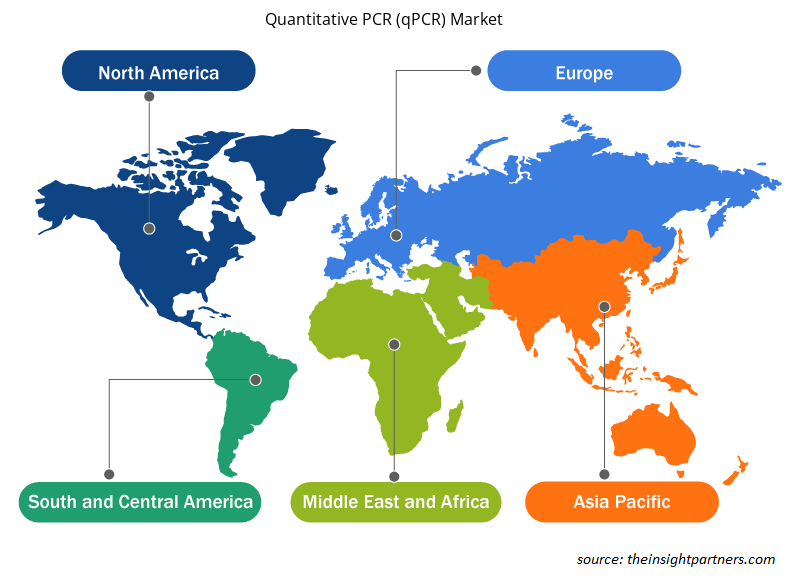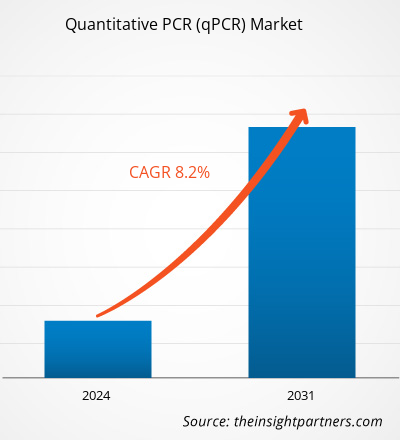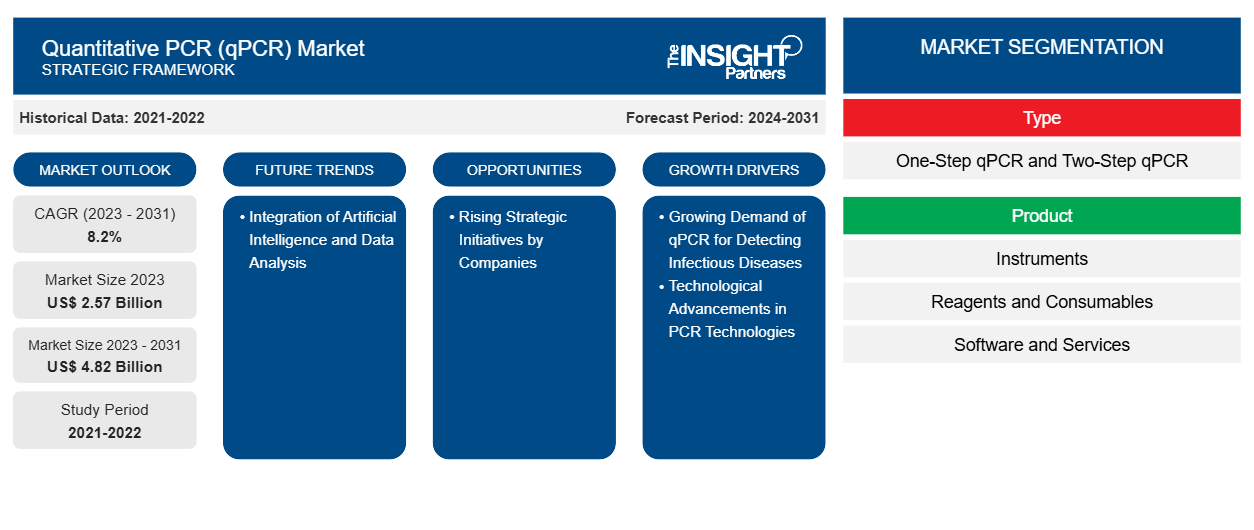Se proyecta que el tamaño del mercado de PCR cuantitativa (qPCR) alcance los 4.820 millones de dólares en 2031, desde los 2.570 millones de dólares en 2023; se estima que el mercado registrará una CAGR del 8,2 % durante 2023-2031.
La qPCR, también conocida como PCR en tiempo real, permite a los usuarios monitorear el progreso de una PCR en tiempo real. El uso de qPCR permite a los profesionales calcular la amplificación de PCR simultáneamente a medida que avanza la reacción. La qPCR es una técnica de diagnóstico ampliamente utilizada en diversos sectores, como la investigación, los productos farmacéuticos y la biotecnología. La demanda de pruebas moleculares se ve impulsada por los avances tecnológicos en los sistemas de PCR y la necesidad de procesos de detección de biomarcadores de cáncer precisos y confiables. Se proyecta que los avances tecnológicos en las tecnologías de qPCR y la creciente demanda de qPCR en el diagnóstico de enfermedades infecciosas impulsarán aún más el crecimiento del mercado en los próximos años. Las tendencias del mercado de PCR cuantitativa (qPCR) incluyen la integración de inteligencia artificial y análisis de datos.
Factores impulsores del crecimiento:
La PCR se ha convertido en una herramienta crucial para diversas aplicaciones o exámenes clínicos y de diagnóstico. La relativa simplicidad, la exquisita sensibilidad y la rentabilidad son algunas de las ventajas notables de la PCR que han aumentado enormemente el uso de la tecnología PCR en los últimos años. Es una tecnología robusta y confiable que se utiliza en la mayoría de los laboratorios de biología molecular para amplificar tramos específicos de ADN para la genotipificación, la clonación y el análisis de variaciones de un solo nucleótido. También sirve como base para la mayoría de las preparaciones de secuenciación de próxima generación (NGS). Los avances tecnológicos están produciendo diferentes tipos de técnicas de PCR. En particular, los sistemas de PCR en tiempo real o qPCR de alta tecnología se utilizan para diagnosticar enfermedades, identificar virus y bacterias y ayudar en las investigaciones forenses. Desde su desarrollo, la qPCR se ha convertido en un componente esencial de la biología molecular y se utiliza ampliamente en la investigación, el diagnóstico clínico y las pruebas de seguridad alimentaria. Sus principales ventajas se basan en las capacidades de cuantificación y genotipificación de cepas virales que ofrece a los usuarios, lo que permite la estimación de la reinfección en función de la cantidad de virus presente en los tejidos diana. Ha transformado el campo de la detección y cuantificación de ácidos nucleicos, permitiendo a los investigadores y profesionales médicos analizar genes, mutaciones y variantes genéticas con un detalle sin precedentes.
La qPCR basada en CRISPR, los sistemas de qPCR automatizados, la qPCR multiplex y la qPCR de próxima generación son ejemplos de avances recientes en la tecnología de qPCR. Con una sensibilidad, especificidad y precisión mejoradas, estos sistemas amplían la aplicación de la qPCR en el diagnóstico clínico, la investigación y las pruebas de seguridad alimentaria , entre otras aplicaciones. Se pueden detectar y cuantificar múltiples secuencias diana en una sola reacción utilizando qPCR multiplex, ahorrando tiempo y reduciendo los requisitos de muestra. Este método es útil para la detección de patógenos, la elaboración de perfiles de expresión genética y el análisis de variación genética. Además, la qPCR de próxima generación ayuda a detectar y cuantificar secuencias de ácidos nucleicos en una variedad de muestras utilizando tecnologías de secuenciación de vanguardia. Esta técnica tiene un alto grado de sensibilidad y precisión para detectar secuencias diana de baja abundancia. Con una cuidadosa consideración del diseño de cebadores, la optimización y la preparación de la muestra, el análisis de qPCR puede generar información valiosa sobre la expresión genética, el diagnóstico de enfermedades y las pruebas de seguridad alimentaria. Por lo tanto, los avances tecnológicos en las tecnologías de PCR están contribuyendo al crecimiento del mercado de PCR cuantitativa (qPCR).
Personalice este informe según sus necesidades
Obtendrá personalización en cualquier informe, sin cargo, incluidas partes de este informe o análisis a nivel de país, paquete de datos de Excel, así como también grandes ofertas y descuentos para empresas emergentes y universidades.
- Obtenga las principales tendencias clave del mercado de este informe.Esta muestra GRATUITA incluirá análisis de datos, desde tendencias del mercado hasta estimaciones y pronósticos.
Segmentación y alcance del informe:
El análisis del mercado de PCR cuantitativa (qPCR) se ha llevado a cabo considerando los siguientes segmentos: tipo, producto, aplicación, usuario final y geografía. Según el tipo, el mercado se segmenta en qPCR de un paso y qPCR de dos pasos. En términos de producto, el mercado se clasifica en reactivos y consumibles, instrumentos y software y servicios. Por aplicación, el mercado se segmenta en investigación, clínica y forense. Según el usuario final, el mercado se clasifica en hospitales y centros de diagnóstico, laboratorios de investigación e institutos académicos, empresas farmacéuticas y biotecnológicas, laboratorios forenses y organizaciones de investigación clínica. El alcance geográfico del informe de mercado de PCR cuantitativa (qPCR) cubre América del Norte (EE. UU., Canadá y México), Europa (Francia, Alemania, Reino Unido, España, Italia y resto de Europa), Asia Pacífico (China, Japón, India, Corea del Sur, Australia y resto de Asia Pacífico), Medio Oriente y África (Arabia Saudita, Sudáfrica, Emiratos Árabes Unidos y resto de Medio Oriente y África) y América del Sur y Central (Brasil, Argentina y resto de América del Sur y Central).
Análisis segmental:
El mercado de PCR cuantitativa (qPCR), por tipo, se clasifica en qPCR de un solo paso y qPCR de dos pasos. El segmento de qPCR de dos pasos tuvo una participación de mercado significativa en 2023. Se prevé que registre una CAGR más alta en el mercado durante 2023-2031.
Según el producto, el mercado se clasifica en reactivos y consumibles, instrumentos y software y servicios. El segmento de reactivos y consumibles tuvo una participación de mercado significativa en PCR cuantitativa (qPCR) en 2023, y se estima que registrará la CAGR más alta durante 2023-2031.
El mercado de PCR cuantitativa (qPCR), por aplicación, se clasifica en investigación, clínica y forense. El segmento clínico tuvo una participación de mercado significativa en 2023. Se prevé que registre la CAGR más alta del mercado durante 2023-2031.
Según el usuario final, el mercado de PCR cuantitativa (qPCR) está segmentado en hospitales y centros de diagnóstico, empresas farmacéuticas y biotecnológicas, laboratorios de investigación e institutos académicos, laboratorios forenses y organizaciones de investigación clínica. El segmento de hospitales y centros de diagnóstico tuvo una participación de mercado significativa en 2023 y se espera que registre la CAGR más alta durante 2023-2031.
Análisis regional:
En términos geográficos, el mercado de PCR cuantitativa (qPCR) está segmentado en América del Norte, Europa, Asia Pacífico, América del Sur y Central, y Oriente Medio y África. En 2023, América del Norte capturó una parte significativa del mercado. En 2023, Estados Unidos dominó el mercado en esta región. El crecimiento del mercado de PCR cuantitativa (qPCR) en América del Norte se atribuye a la extensa I+D realizada en varios institutos académicos y de investigación, al creciente enfoque en el empleo de técnicas y herramientas avanzadas en la atención médica, a las iniciativas gubernamentales y privadas y a los fondos para promover la medicina de precisión , así como la investigación genómica, al aumento de la demanda de productos innovadores de las empresas de PCR y a la presencia de actores clave del mercado.
En junio de 2020, Azure Biosystems lanzó el instrumento de PCR en tiempo real Azure Cielo. Cielo es una máquina de PCR cuantitativa de 96 pocillos que mantiene la promesa de la marca de diseño compacto, alto rendimiento y flujo de trabajo intuitivo. La sensibilidad y confiabilidad de Azure Biosystem se han dedicado a las aplicaciones genómicas. Cielo es el primer instrumento dedicado al flujo de trabajo genómico de la empresa.
Desarrollos industriales y oportunidades futuras:
El informe de mercado de PCR cuantitativa (qPCR) incluye el posicionamiento y la concentración de la empresa para evaluar el desempeño de los competidores en el mercado. Según los comunicados de prensa de la empresa, a continuación se presentan algunas iniciativas adoptadas por los actores clave que operan en el mercado:
- En mayo de 2023, Standard BioTools Inc. lanzó la función de preparación de bibliotecas NGS en el sistema de genómica de alto rendimiento X9. Con este lanzamiento, los clientes pueden ejecutar aplicaciones de preparación de bibliotecas NGS y PCR en tiempo real en un solo sistema de sobremesa para respaldar el descubrimiento mediante la detección.
- En marzo de 2021, Agilent Technologies Inc. presentó un kit de diagnóstico basado en PCR con transcripción inversa (qRT) en tiempo real para la detección del ARN del SARS-CoV-2. El kit Agilent SARS-CoV-2 qRT-PCR Dx es un kit de reactivos de diagnóstico in vitro para detectar el ARN del SARS-CoV-2 mediante qRT-PCR. El ensayo de un solo tubo permite una mayor eficiencia, un mayor rendimiento, un menor uso de consumibles y resultados inequívocos para la confianza en los resultados de las pruebas.
Perspectivas regionales del mercado de PCR cuantitativa (qPCR)
Los analistas de Insight Partners explicaron en detalle las tendencias y los factores regionales que influyen en el mercado de PCR cuantitativa (qPCR) durante el período de pronóstico. Esta sección también analiza los segmentos y la geografía del mercado de PCR cuantitativa (qPCR) en América del Norte, Europa, Asia Pacífico, Oriente Medio y África, y América del Sur y Central.

- Obtenga datos regionales específicos para el mercado de PCR cuantitativa (qPCR)
Alcance del informe de mercado de PCR cuantitativa (qPCR)
| Atributo del informe | Detalles |
|---|---|
| Tamaño del mercado en 2023 | US$ 2,57 mil millones |
| Tamaño del mercado en 2031 | 4.820 millones de dólares estadounidenses |
| CAGR global (2023 - 2031) | 8,2% |
| Datos históricos | 2021-2022 |
| Período de pronóstico | 2024-2031 |
| Segmentos cubiertos | Por tipo
|
| Regiones y países cubiertos | América del norte
|
| Líderes del mercado y perfiles de empresas clave |
|
Densidad de actores del mercado de PCR cuantitativa (qPCR): comprensión de su impacto en la dinámica empresarial
El mercado de PCR cuantitativa (qPCR) está creciendo rápidamente, impulsado por la creciente demanda de los usuarios finales debido a factores como la evolución de las preferencias de los consumidores, los avances tecnológicos y una mayor conciencia de los beneficios del producto. A medida que aumenta la demanda, las empresas amplían sus ofertas, innovan para satisfacer las necesidades de los consumidores y aprovechan las tendencias emergentes, lo que impulsa aún más el crecimiento del mercado.
La densidad de actores del mercado se refiere a la distribución de las empresas o firmas que operan dentro de un mercado o industria en particular. Indica cuántos competidores (actores del mercado) están presentes en un espacio de mercado determinado en relación con su tamaño o valor total de mercado.
Las principales empresas que operan en el mercado de PCR cuantitativa (qPCR) son:
- Laboratorios Abbott
- Termo Fisher Scientific Inc.
- Biotools estándar inc.
- F. Hoffmann-la Roche Ltd
- Qiagen
- Tecnología médica Lepu de Pekín, empresa limitada
Descargo de responsabilidad : Las empresas enumeradas anteriormente no están clasificadas en ningún orden particular.

- Obtenga una descripción general de los principales actores clave del mercado de PCR cuantitativa (qPCR)
Panorama competitivo y empresas clave:
El pronóstico del mercado de PCR cuantitativa (qPCR) puede ayudar a las partes interesadas a planificar sus estrategias de crecimiento. Abbott Laboratories, Thermo Fisher Scientific Inc., Standard Biotools Inc., F. Hoffmann-la Roche Ltd, Qiagen, Lepu Medical Technology Beijing Co Ltd, Bio-rad Laboratories Inc., Takara Bio Inc., Agilent Technologies Inc. y Fujirebio se encuentran entre los actores destacados del mercado. Estas empresas se centran en la introducción de nuevos productos de alta tecnología, avances en productos existentes y expansiones geográficas para satisfacer la creciente demanda de los consumidores en todo el mundo.
- Análisis histórico (2 años), año base, pronóstico (7 años) con CAGR
- Análisis PEST y FODA
- Tamaño del mercado, valor/volumen: global, regional y nacional
- Industria y panorama competitivo
- Conjunto de datos de Excel
Informes recientes
Testimonios
Razón para comprar
- Toma de decisiones informada
- Comprensión de la dinámica del mercado
- Análisis competitivo
- Información sobre clientes
- Pronósticos del mercado
- Mitigación de riesgos
- Planificación estratégica
- Justificación de la inversión
- Identificación de mercados emergentes
- Mejora de las estrategias de marketing
- Impulso de la eficiencia operativa
- Alineación con las tendencias regulatorias





















 Obtenga una muestra gratuita para - Mercado de PCR cuantitativa (qPCR)
Obtenga una muestra gratuita para - Mercado de PCR cuantitativa (qPCR)